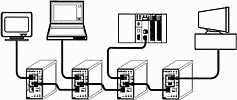
In Part I Contemporary Controls discussed the first four issues in this series: topology, cabling, connectors and connections and industrial Ethernet or COTS. Part II's discussion continues with a look at speed and distance.
Speed and distance
Although the IEEE 802,3 standard addresses data rates from 1 Mbps to 1000 Mbps (soon to be 10 000), 10 Mbps are of the most interest. Of course most people think faster is better. However, there are tradeoffs, especially when it comes to shared Ethernet. Shared Ethernet or half-duplex Ethernet is the original technology where medium access is determined by the ever famous carrier-sense, multiple access with collision detection (CSMA/CD) algorithm. With a half-duplex medium, transmitting and receiving is possible but not at the same time, otherwise a data collision will occur. Before a station initiates a transmission, it first waits for a clear channel. During the transmission, the originating station listens for a time to ensure that the transmission is faithfully produced and that no other station attempts a simultaneous transmission. If one occurs, this is called a collision and the originating station will reinforce the collision by applying a jam signal. All stations will notice the collision and will discard the frame. The competing stations will back off for a random amount of time (based upon an algorithm) and will renew their attempt. In order for this mechanism to function, all stations and all hubs must reside is what is called a collision domain.

In Figure 1 you will notice several devices attached to the same network, interconnected with four repeating hubs. The complete network is contained in one collision domain. All cabling is assumed to be twisted-pair. Also assume that we are operating at 10 Mbps. There are several factors that limit distance. The first is the maximum segment length which is limited to 100 m at either 10 or 100 Mbps. A segment is a continuous length of cable between any two devices. Devices could be either hubs or workstations. The second limitation on distance is the maximum network diameter, which is limited by the collision domain. The distance between the furthest devices within the network is called the network diameter. In order for the collision detection mechanism to function, the round trip propagation time between the two furthest devices must be shorter than the Ethernet slot time plus preamble. The slot time is the time it takes to send 64 bytes and the preamble requires 8 bytes. At 10 Mbps this translates to 57,5 µs. Since the time it takes for a signal to propagate down a twisted-pair cable (5,65 ns/m) is the same at 10 Mbps as it is at 100 Mbps, the network diameter is drastically reduced at 100 Mbps. The IEEE 802,3 standard has a length; however, the rules are not simple. One rule we can use, however, is the 5-4-3 rule.
The 5-4-3 rule only pertains to 10 Mbps repeater operation. The rule states that a network can have up to five segments, four repeaters and no more than three mixing segments. A mixing segment is a coaxial bus segment which we are ignoring. Therefore, network diameter is 500 m. This is a simple and effective rule, although somewhat conservative. The rule is not very helpful when it comes to fibre.
Although fibre-optic segments can be up to 2 km, you are not allowed to cascade five segments. The IEEE 802,3 standard says that if you limit the number of repeaters to three and retain twisted-pair segments at each end of the network, the two remaining segments can be fibre-optic as long as each segment does not exceed 1 km. From this you can assume that if you eliminate one repeater and one fibre optic segment, the remaining fibre optic segment can be increased to its 2 km limit. The 5-4-3 rule is not applicable at 100 Mbps. Although 100 Mbps repeaters exist, their use is severely restricted. At 100 Mbps the use of switches is recommended. At 10 Mbps either repeating hubs or switching hubs is recommended.
Part III will continue in a subsequent issue and will look at hubs versus switches.
| Tel: | +27 12 493 0852 |
| Email: | [email protected] |
| www: | www.epd.co.za |
| Articles: | More information and articles about Electronic Products Design |

© Technews Publishing (Pty) Ltd | All Rights Reserved